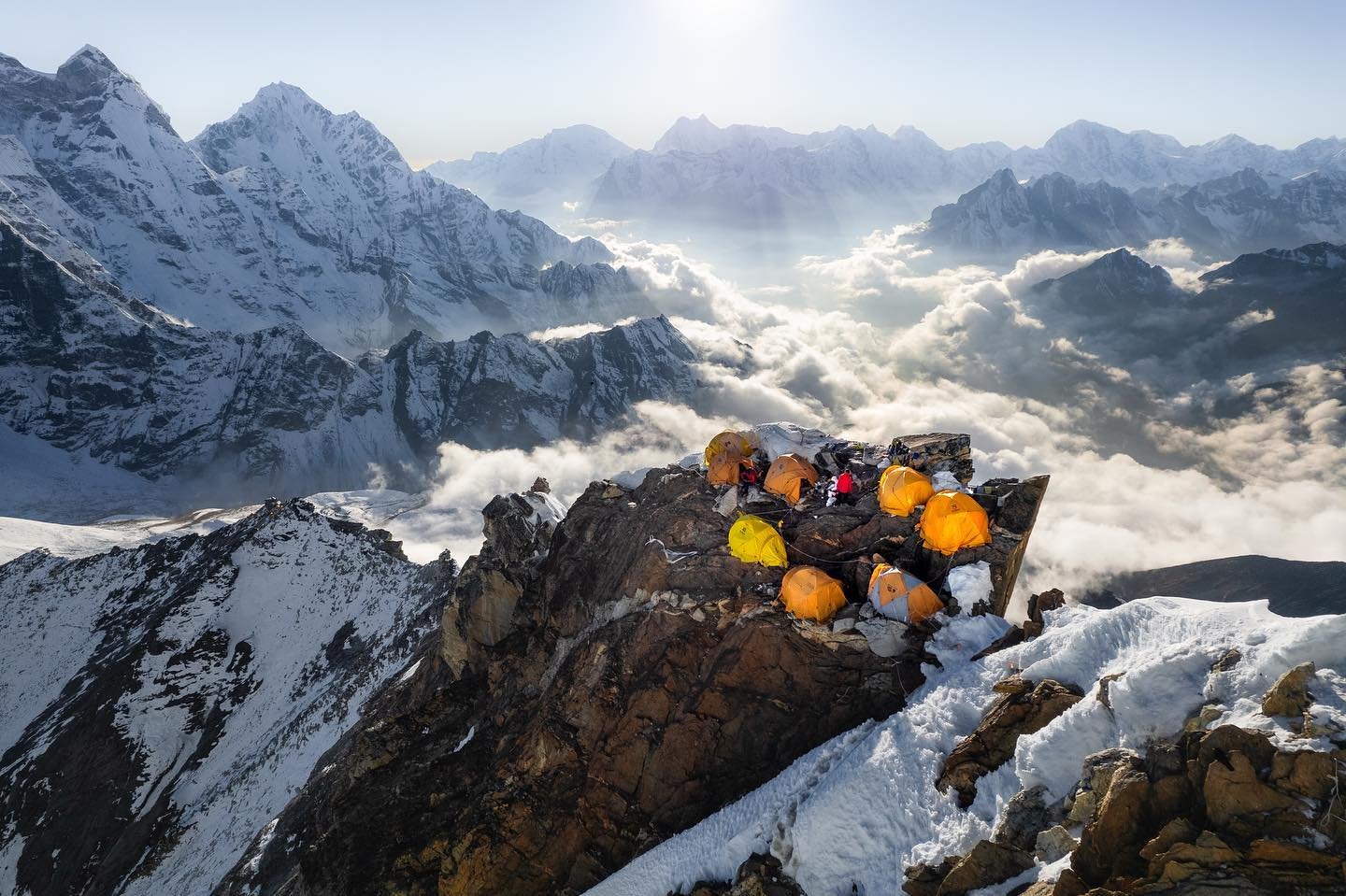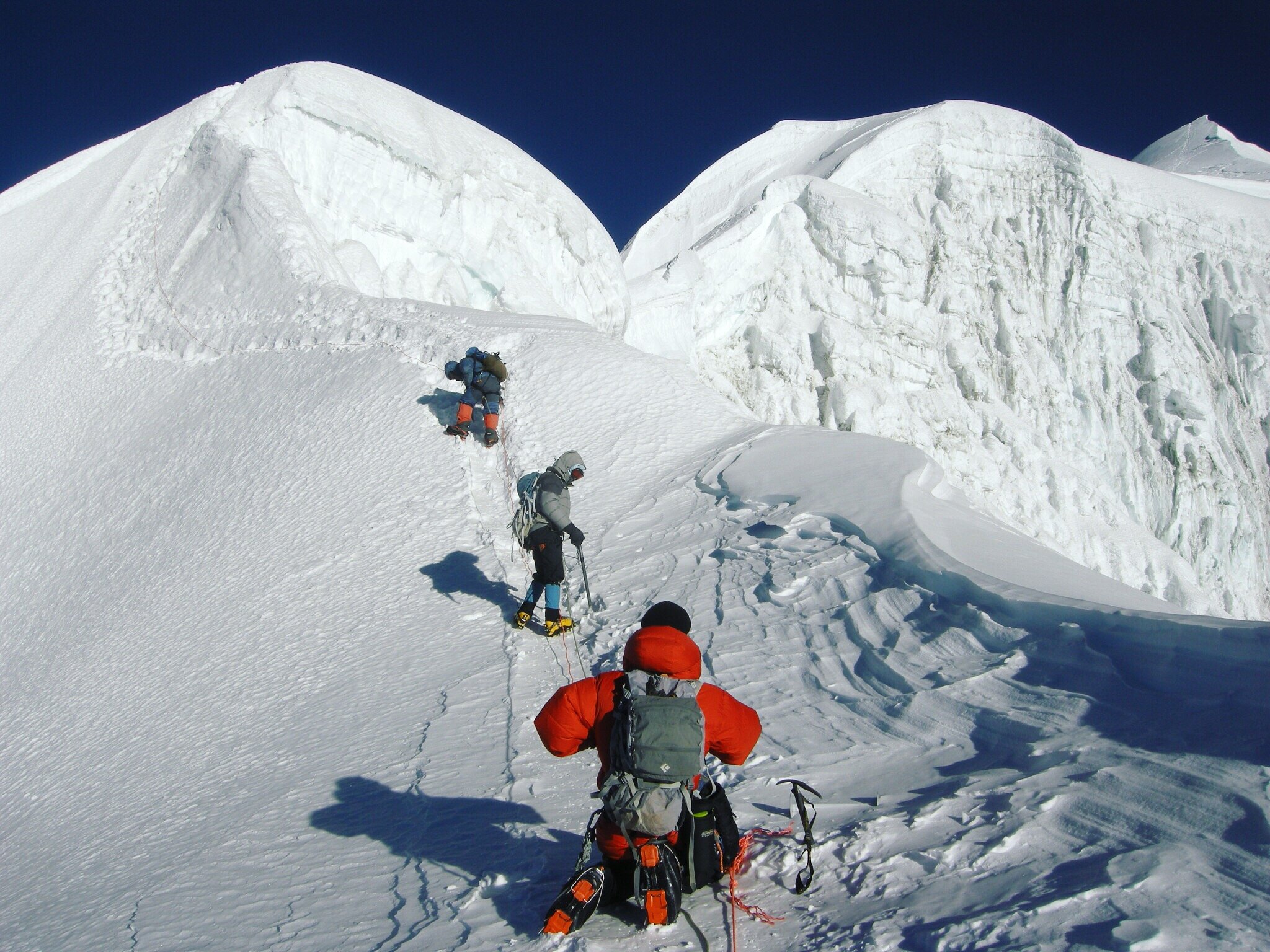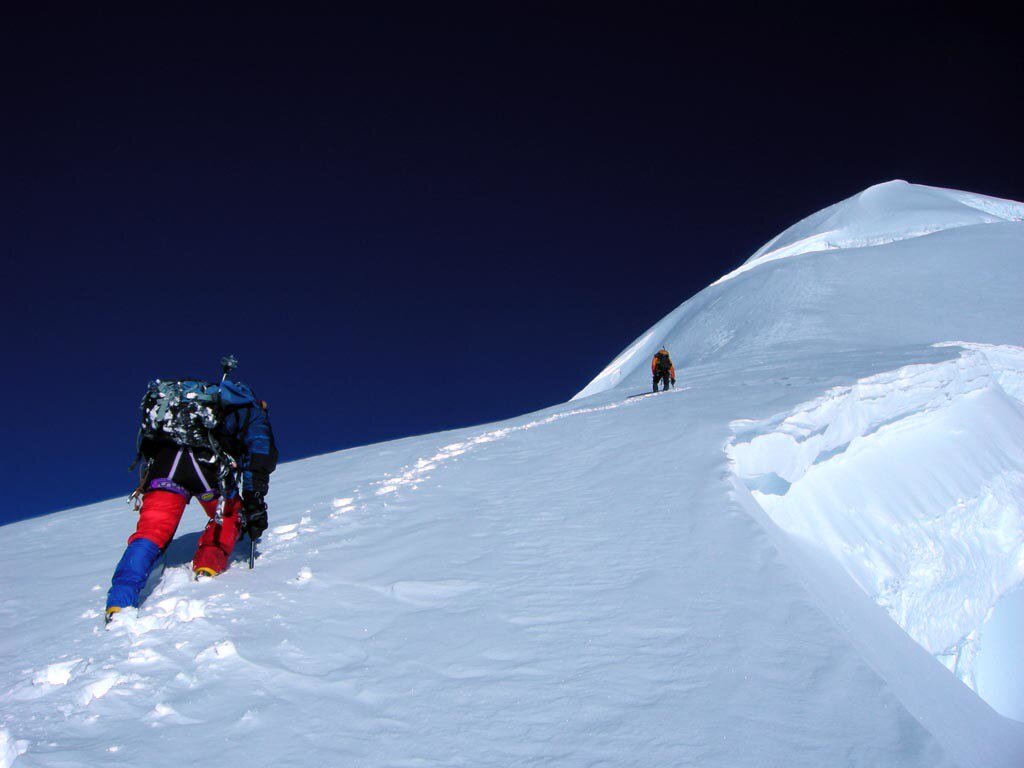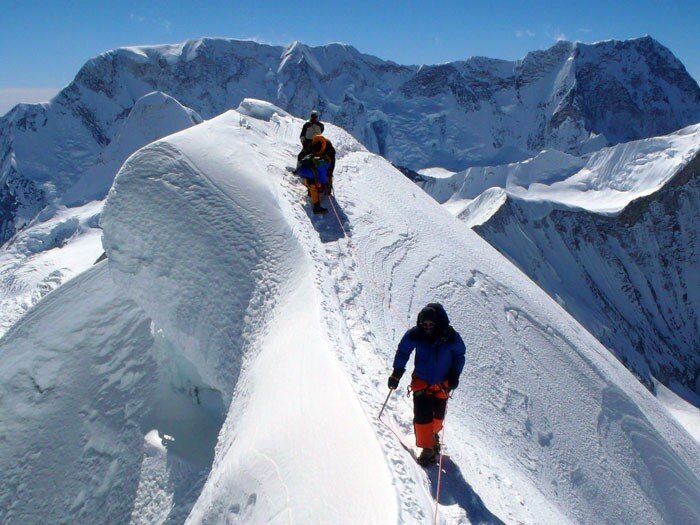Visual Journey of Ama Dablam Expedition - Namas Adventure
VISUAL JOURNEY OF AMA DABLAM EXPEDITION
Ama Dablam's expedition is one of the most thrilling climbs in the Khumbu region. Ama Dablam's view dominates the view during Everest trekking routes. Not only is the climb beautiful and challenging but also physically/mentally demanding. Land in the buzzing historic city of Kathmandu following then to the famous Lukla airport your expedition begins. Your trek follows through the same trail of the iconic Everest base camp trek. The route then splits from the Pangboche village (4529M) to the Ama Dablam base camp 4529M and into the mountain.
Follow along as we describe the entire journey in images, as we take the beautiful yet challenging journey up to the summit of Ama Dablam 6810M.
Lukla Airport
Namche Bazaar
Everest trail and Ama Dablam on the right, Everest/Lhotse on the right background
Trek via the beautiful Gokyo lake 4900M
Dingboche. Island Peak far-left background and Ama Dablam on the right.
Island Peak 6189M. Acclimatization training peak.
Island Peak (Imja-Tse) is one of the most popular 6,000M+ climbing peaks in Nepal. The peak is actually an extension of the ridge coming down off the south end of Lhotse Shar. Imja Tse is a popular mountaineering objective for climbers in Nepal, with its standard climbing route having the difficulty rating of Alpine/fitness PD/2. Our team utilizes Island Peak 6189M or Lobuche East 6119M for training/acclimatization peak before climbing Ama Dablam. The climb in these peaks is an accomplishment on its own and an experience to climb another 6000M peak in the Khumbu region.
Ama Dablam Base Camp 4529M
This will be climbers home for 12-14 days. This will be a full fledge camp with kitchen/dining tent, resting camp where the rest of the crew will be there to support the expeditions.
Ama Dablam Base Camp 4529M
Camp 1 (5800M)
The route to camp 1 is mostly traversing on rocky boulders, a somewhat loose and exposed ridge that is mostly dry during the autumn season and mixed with ice and snow during the spring season. Camp 1, can accommodate about 10 - 12 tents, which are set on the slopes of the rocky boulders and overcrowding can be an issue when all the teams are planning their final summit bid at the same time. The journey from base camp to camp 1 takes about 5 - 6 hours.
Camp 2, 6200M “Yellow Tower”
The duration from camp 1 to camp 2 takes about 4-5 hours. As soon as climbers start off their journey from camp 1 the climb begins through clipping on a fixed-line.
The route is on the steep ridge, exposed on both sides. The routes on the way to camp 2 are stable. After traversing on the boulders and snow the final challenge for the day arrives at the yellow tower. The daunting “Yellow tower” is a straight 80 - 90 degrees vertical wall. Climbing with all the loads can be quite a challenge. So climbers need to be on their game on this part of the climb. Yellow tower climb can be graded at 6a rock climbing grade.
Camp 2 can only house about 7 to 8 tents so during the busy season it is hard to find the ideal spot and when overcrowded other makeshift camps have to be set up on the edges. This camp is not for the faint-hearted climbers but views from camp 2 are just out of this world.
Climbing the Mushroom ridge to Camp 3 (Situational)
The mushroom ridge traverse is one of the most challenging parts of climbing up to camp 3 and when descending down after summit bid. Rock falls can occur if climbers are ahead and climbers will have to traverse through a couloir on thier way to camp 3. This is the final technical section before reaching camp 3 or the summit.
Route to Ama Dablam Camp 3 (6400M)
Camp 3 depends a lot on the condition of snow and ice in the mountain. (Most likely to be set up during spring season than autumn.) The route goes from the back of the tower. Very exposed section and again depending on the season climbers will have to traverse on ice or granite slabs. Rockfalls can occur when there are lots of other climbing teams ahead. Some have even reported rocks the size of a football (soccer). The climb up is 70-80 degrees vertical and upon traversing climbers will reach the uncompromising mushroom ridge.
Lots of new and old fixed ropes can be found on this section. When climbing in the dark make sure to clip onto the right fixed line. Traversing through another super steep couloir on the ridge and steadily heading up climbers will arrive at camp 3 area. By this point, you will already have climbed for 5 hours. Nowadays, most teams do not stop at camp 3 and head straight to the summit. Arriving just beneath the pyramid the summit lies above the Dablam slopes.
Summit 6810M
Summit of Ama Dablam is a broad plateau. An amazing feat to undertake and the achievement of a lifetime. On a clear day Mt. Everest, Lhotse Shar, Baruntse, Makalu, Cholatse, Taboche, and surrounding Himalayan peaks are visible.
AMA DABLAM EXPEDITION
Are you planning the Ama Dablam expedition as your next big mountaineering adventure? We have departures every year (spring/autumn). For more information on our Ama Dablam expedition or any of our other international expeditions check out our website. (Call/WhatsApp) - +44 7446976060 or send us an email at bookings@namasadventure.com
Ama Dablam Expedition : A Climbers’ Guide - Namas Adventure
Mountain Overview
Elevation: 6810M / 23389FT
Co-ordinates: 27.8619° N, 86.8612° E
Location: Khumbu Region
Parent Mountain: None
Summits: 1 Main summit
Country: Nepal
About the Mountain
Ama Dablam is well renowned as one of the most beautiful and exposed Himalayan mountains in the Everest region. It is one of the most sought mountains to climb by mountaineering enthusiasts. Ama Dablam is the 3rd highest permit to be issued by NMA. Whether you plan to do it before or after your bigger expedition like Everest, Ama Dablam climb in itself is a mountaineering challenge on its own. Ama Dablam is referred to as the mountaineer’s mountain and is considered "a must-do" for alpinists and mountaineers. Ama Dablam is also referred to as the Matterhorn of Nepal.
History
Ama Dablam was first summited on 13th March 1961, a Silver hut scientific expedition led by Sir Edmund Hillary. Mike Gill (NZ), Barry Bishop (US), Mike Ward (UK), and Wally Romanes (NZ),
How to get here?
There is one main trekking route to get to Ama Dablam base camp.
Via Lukla - Namche Bazzar - Pangboche - Ama Dablam Base Camp (Hiking)
Ama Dablam Routes
Southwest Ridge (Commercial expedition route)
1979 Lowe Route on the South Face (VI AI4 M5 1200m)
1979 North Ridge (VI 5.7 70deg 1600m)
1981 Northeast Spur to North Ridge (VI 5.7 70deg 1500m)
1983 East Ridge (VI 80deg 1500m)
1984 Southwest Ridge
1985 West face (VI 5.7 65deg 1400m)
1985 Northeast Face (VI mixed 90deg 1400m)
1996 Northwest face (VI 5.7 AI5 A2+ 1650m)
1996 North Ridge
2001 Northwest Ridge
Note - Climbers planning to climb this Ama Dablam without guide support or solo projects are advised to take other routes than (Southwest ridge) because it conflicts with the commercial expedition.
Permits
Required. Permit costs $400 (Spring and Autumn) and $200, Winter. Liaison officer charges apply.
When to climb Ama Dablam?
Spring season (April - May) if you prefer to see fewer climbing teams in the mountains.
Autumn (Mid October - November) is more famous and expect to see many teams and traffic during this season.
Winter ( Mid December - Mid February)
Ama Dablam Base Camp 4529M
A few hours away from Pangboche, the Ama Dablam base camp sits at 4529M. This will be the home for many climbers for their entire climbing duration. The base camp is set up on grassy lands just beneath the mountain. A cell tower has been set up close to the Ama Dablam base camp, providing climbers with inconsistent internet access, but still decent service. An old yak hut has been transformed into a tea house, which is a short distance from the base camp. Independent climbers can use this as their permanent base camp or store their gear.
Camp 1, 5800M
It takes about 5-6 hours to reach Camp 1 from the base camp of Ama Dablam. Along the way, climbers will come across Yak Camp, which can also serve as an advanced base camp. However, the availability of water at this campsite is limited, so many teams do not use it or only use it for acclimatization rotations. The route to Camp 1 involves traversing rocky boulders and an exposed, somewhat loose ridge, which is typically dry during the autumn season. Camp 1 can accommodate 10-12 tents, which are set on the slopes of rocky boulders. Overcrowding can be an issue when all teams are planning their final summit bids at the same time.
Camp 2, 6100M (Yellow Tower)
The journey from Camp 1 to Camp 2 can take about 4 to 6 hours. After leaving Camp 1, climbers will have to clip onto the fixed ropes to make their way to the next camp. The route follows a steep ridge, exposed on both sides, with stable routes on the way to Camp 2. As climbers traverse the boulders and snow, they will face the final challenge of the day: the daunting "Yellow Tower," a vertical wall at an 80 to 90-degree angle. Climbing with all the necessary gear can be quite a challenge, so it is important for climbers to be prepared for this part of the ascent. The Yellow Tower climb can be graded at a 5.10 rock climbing level.
During the busy season, finding a spot in Camp 2 can be difficult as it only accommodates 7 to 8 tents. If the camp becomes overcrowded, additional makeshift camps may need to be set up on the edges. While this camp may not be suitable for those who are easily intimidated, it offers breathtaking views.
Camp 3 or 2.9,
Climbing towards camp 3, Ama Dablam
Camp 3 depends a lot on the condition of the snow and ice in the mountain. (It is most likely to be set up during the spring season rather than autumn.) The route goes from the back of the tower and is a very exposed section. Depending on the season, climbers will have to traverse on ice or granite slabs. Rockfalls can occur when there are many other climbing teams ahead. Some climbers have even reported rocks the size of a soccer ball. The climb up is 70-80 degrees vertical, and upon traversing, climbers will reach the uncompromising mushroom ridge.
As you navigate this section of the climb, you will encounter many new and old fixed ropes. It is important to pay attention and make sure you are clipping onto the correct rope, especially when climbing in the dark. After traversing a steep couloir and steadily making your way up the ridge, you will reach the area for Camp 3. After approximately 5 hours of climbing, many teams choose to skip this camp and continue directly to the summit. When you reach the base of the pyramid, the summit will be located above the Dablam slopes.
Camp 3, Ama Dablam. Photo by - Irina Galay
Ama Dablam Summit 6810M
Climbing further up on 55-65 degree slopes will lead to the final stretch before reaching the summit. Expect to climb for more than 10+ hours if you are planning to ascend directly from camp 2. The summit of Ama Dablam is a wide and broad plateau. On a clear day Mt. Everest, Makalu 8463M, and Baruntse 7129M ranges are clearly seen.
Prayer flags at Ama Dablam summit 6810M
Your climb is half done at this point. Abseiling down to camp 3 is straightforward, although some climbers wrap the ropes around their arms and make a speedy descent, which is not recommended. The mushroom ridge and couloir areas can be challenging during the descent, as they can be gnarly and tiring. It's important to stay focused and on top of your climbing skills, as you may already be fatigued from the climb to the summit. Once you've successfully crossed these challenging sections, you will arrive at camp 2.
We usually plan to spend the night at this camp, but very fit climbers may be able to descend further down to Camp 1. However, descending the Yellow Tower is not easy either; it's a 90-degree descent, so be sure to have enough strength left to rappel down and traverse the uncomfortable granite before reaching Camp 1. The descent to Base Camp is straightforward, where your comfortable camp awaits.
Express Itinerary
With the use of helicopters after the summit, the expedition can be shortened up to 21 days. Flying from Ama Dablam BC to Lukla or Kathmandu.
Some climbers arrive in Nepal with hypoxic pre-acclimatization training and do a speed climb on several mountains including Ama Dablam.
Further extensions
(i) Baruntse expedition.
Baruntse 7129M mountain peak can be your further extension going higher into a 7000M altitude zone. Additional 15 days will be required to take on this remote peak in the Makalu/Barun valley.
Continued further down via Amphu Lhabtsa pass, towards Baruntse west col and then finally climbing down via Sherini col to arrive at Makalu base camp to climb. Extra 20 - 25 days required to climb Makalu (with contingency days) We highly recommend spring season if you are to plan Makalu expedition as the weather is more stable during spring than the autumn season.
Are you planning to climb Ama Dablam someday in the near future? If yes then our team specializes in remote mountain peaks in the Himalayan region. We go where few ventures, safely access and navigate these parts of the Himalayas, creating new possibilities in the mountains.
For more information on our Baruntse expedition or Baruntse Express expedition or any of our other international expeditions check out our website. (Call/WhatsApp) - +44 7446976060 or send us an email at bookings@namasadventure.com
Go. Explore more.
Live Your Story
When to climb Ama Dablam? (Spring or Autumn) - Namas Adventure
When planning an expedition to climb Ama Dablam in Nepal, you may be wondering what the best time to tackle this peak is. With years of experience leading expeditions and local knowledge from our guides, we can say that it really depends on your preference for climbing in different conditions. Luckily, Ama Dablam is accessible for climbing in both spring and autumn. In this article, we will outline the conditions you can expect during each season, so you can choose the one that best fits your style and preferences.
What’s the difference between Spring & Autumn climb? 🧗
There are fewer climbers during the spring season (70% fewer climbers) compared to the autumn season.
More snow/Ice on the mountain during the spring season result.
The spring season sees a longer daylight duration compared to the autumn season.
Spring climbing days are colder & more snow showers are to be expected.
Autumn sees more stable weather compared to the spring season.
More Avalanche prone (Camp 3) during Autumn.
Spring (Mid March - End May) sees a lot more snow compared to autumn. The spring season on Ama Dablam is a true test of adventure and endurance. With fewer crowds and the added challenge of fresh, deep snow, it's the perfect opportunity for thrill-seekers to test their mettle. The chance to stake a claim on the notorious Yellow Tower is a rare and coveted opportunity, and the chance to tackle the mountain's vertical and exposed sections with minimal traffic is an experience not to be missed. Spring tests your patience, especially when things don't go according to plan, and teams may need to improvise a lot. That's why spring sees fewer climbers on other peaks (excluding Everest and Lhotse) compared to autumn. However, when spring does offer clear weather, it is one of the best times to climb in Nepal.
Irina Galay - Ama Dablam Spring Expedition
Autumn (Mid-September - End of November) attracts many climbers to most of the peaks in Nepal. The snow and ice melt during spring and monsoon, revealing granite rock formations that are visible while climbing. The post-monsoon air brings clean and crisp conditions, and the snow in the Himalayan peaks has melted and settled significantly compared to the deep, snowy conditions of spring. This makes the climbing conditions more favorable for all climbers. The season starts earlier, with shorter days and stable weather conditions. The autumn season begins in September and typically sees snowfall towards the end of November, with heavy falls expected as winter approaches. Ama Dablam is particularly popular with climbers during this season, and is probably the most famous peak to climb in autumn."
Conclusion
As you stand at the base of Ama Dablam, the icy peak towering above you, you can't help but feel a surge of excitement and nerves. This is a mountain that demands respect, with its steep, technical routes and high altitudes. But you are ready for the challenge.
Whether you choose to brave the snowy conditions of spring or the crisp, stable autumn weather, one thing is certain: this will be an adventure you'll never forget. With fewer climbers on the mountain during the spring season, you may even have the chance to claim your own slice of solitude on the iconic Yellow Tower.
As you make your way up the mountain, the challenges will come thick and fast. From vertical ice walls to exposed traverses, Ama Dablam will test every ounce of your skill and determination. But as you stand on the summit, triumphant, you'll know that the reward was worth it.
So what are you waiting for? Grab your gear and join us on an unforgettable journey to the top of Ama Dablam. It may be tough, but the memories you'll make will last a lifetime
Lets, go summit Ama Dablam and other peaks around the world.
Go.
Live Your Story.
Question.
Which season do you plan to climb Ama Dablam & Island Peak (or Lobuche East(? Please comment below, we’d love to hear from you.
We organize Ama Dablam and Island Peak expedition (or Lobuche East via Gokyo) every year during spring and occasionally during autumn. Planning to climb Baruntse one day? Whatever your climbing goal is drop us an email. Our team will be glad to have you onboard and together we shall achieve the summit and enjoy the climbing experience. Our team is here to assist and make your climb in the Himalayas an enjoyable, accessible, and comfortable one.

































